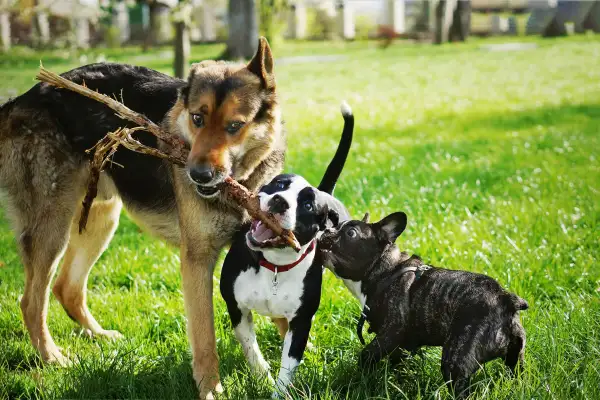Got a Backyard? You Can Make Thousands a Month by Letting Dogs Come Play in It

When Kelley and Denis O’Sullivan bought their Bay Area home four years ago, it came with a massive backyard. The previous owners had raised horses on the property, but the O’Sullivans had no practical use for the now-empty piece of land. Still, they wanted to do something with it.
A few years later, Kelley saw an ad on Facebook for Sniffspot, a company that connects pet owners to people who have private outdoor spaces where dogs can safely run off-leash.
“I was like, ‘oh, that’s interesting. I wonder what that’s about,’" she says. "And here we are."
After making some repairs to their fencing and bringing in some doggie essentials like drinking water, toys and poop bags, the couple listed their yard on Sniffspot last spring, charging $10 an hour for the nearly one-acre space. They even gave their “spot” a name: #349 K9 Farm, a nod to the badge number of their daughter, a Sacramento police officer who was killed in the line of duty in 2019.
Since then, they’ve developed a core group of regulars. The couple had 80 bookings last month alone — netting an extra $1,300 in side income, says Kelley, who works as a personal trainer. (Denis works in IT).
“If you’re looking to kind of dip your toe into a side hustle, this is definitely one to do,” she says.
Off-leash dog parks at a reasonable price
Sniffspot, which launched in 2018, is one of the newer iterations of the so-called sharing economy.
It’s sort of like Rover (which itself is sort of like the Airbnb of dog boarding), but for shorter periods (usually about an hour or two) geared to dog owners who want to give their pets more exercise than their home space allows, and who can’t, for whatever reason, take them to a dog park.
Each "spot" looks a little different. Some are just large fenced-in lawns for playing fetch; others provide everything from toys and agility equipment to doggie—and sometimes human—pools. (The O’Sullivans, for their part, have canine parkour obstacles, a designated “digging spot” and a shaded hang-out area for pet parents).
Founder David Adams says the idea behind the company came from his girlfriend, who wanted to find a place for her dog, Toshii, to run off-leash without fear of him getting lost or running into danger. Dog parks can be scary places, after all — you never know who will turn up, or if your pet will get along with the others there. Wouldn’t it be great if there were an app for that?
“When you’re out there in public around other dogs, you really don’t have control over what can happen,” Adams says.
Shortly after, Adams, who was working as an Entrepreneur in Residence at the investment firm Battery Ventures at the time, launched Sniffspot from his home in Seattle, Washington. It debuted to little fanfare, racking up just 20 bookings in the first month.
“I had this vision it was going to be huge immediately,” Adams says. “I was underwhelmed.”
At the onset of the COVID-19 pandemic, things changed. Many cities closed down public parks, making dog owners desperate for accessible green spaces. Sniffspot also started gaining traction among animal rescue and foster groups, who used it—and still do today—to book spots for behavioral training sessions and meet-and-greets with potential adopters and their dogs.
Zoe Hawkins-Wells, a certified dog trainer in Asheville, North Carolina, says the app gives her canine clients the opportunity to “[Use] their senses in nature, with the freedom of choice in their actions, which is often taken away from them by being on a leash or in tightly contained areas.”
Put simply, “Sniffspot gifts dogs with what they need: time and space for dogs to be dogs,” she says.
Today, there are thousands of Sniffspots in the U.S., and that number is growing: about 10% to 15% each month since 2018, Adams says. As of this writing, Sniffspot has about 7,000 hosts in over 1,500 U.S. cities. Hosts are starting to pop up internationally, too, in places like Canada, Europe and New Zealand.
“It turns out it was relevant for every dog,” Adams says.
How Sniffspot works
Using a business model similar to Airbnb’s, Sniffspot vets potential hosts to make sure their space meets the company's safety requirements, like proper fencing and a yard free of debris, poisonous plants and other hazards.
Once approved, the “spot” is listed on the website with all the necessary details: how big the yard is, what amenities are provided, rules to keep in mind and cost.
The average host rents out their yard for $15 an hour per dog (additional dogs are usually half-price), according to Adams, though some hosts charge as little as $4 and as much as $50 per hour, depending on their location, the size of their yard and what extra conveniences they’ve included.
Sniffspot charges its hosts a 22% fee — in exchange, they get access to the company’s booking site, 24-hour customer service and liability and property damage insurance. (Hosts are responsible for paying credit card processing fees, which add up to another 5%.) In total, hosts take home 73% of the money paid by guests. Top hosts net around $3,000 a month, he says.
Since the goal is to provide a safe space for dogs to get off-leash exercise, scheduled appointments have 30-minute intervals between guests. This gives owners both privacy and peace of mind that there won’t be any confrontations between their dog and others entering or exiting the space.
How to make money on Sniffspot
Opening up your yard to pooches (and their humans) can be a rewarding experience. But before you take the plunge, there are a few details to consider. Here are the major ones.
1. Check the requirements for operating a business in your area
You may be required to get a business license before signing up as a host. Check your local government’s small business website to see what the licensing requirements are and, if you’re unsure, file an inquiry about whether becoming a Sniffspot host is allowed in your area.
You may also be required to obtain an Employer Identification Number, or Federal Tax Identification Number, which comes with a fee ranging from $25 to several hundred dollars. Check with a tax expert to verify what documents you’ll need to complete that process.
2. Make sure your yard is safe
Sniffspot requires all of the yards available for rent on its site to be fenced-in and secure. For some people, that means building (or repairing) fencing that’s free of gaps and high enough to keep dogs from jumping over. Most yards on the site have fences that are at least four feet high, according to the company.
If you use pesticides in the space, you’ll need to prove they’re pet-friendly. You’ll also need to make sure dogs won’t have access to any toxic plants. Sniffspot will provide a list of poisonous plants to check for and, if necessary, take out.
3. Decide what amenities you want to offer
Some hosts only provide a secure yard area with a water bowl and some poop bags. Others have hiking trails, agility courses, dog hammocks and human-friendly amenities like barbeques and fire pits. The size of your yard will help determine what kind of space you want to provide — and how much you can charge for it.
How involved you want to be with your guests—whether you want to greet each one or stay unseen while the spot is in use—is also totally up to you.
4. Be a good neighbor
Keep an open line of communication with your neighbors. Make sure there is enough parking available for your guests without creating problems on your street. And if you know your neighbor’s dog gets taken out at a certain time each day, schedule bookings around that window to avoid potential confrontations.
More from Money:
Everything You Need to Know to Adopt a Dog

